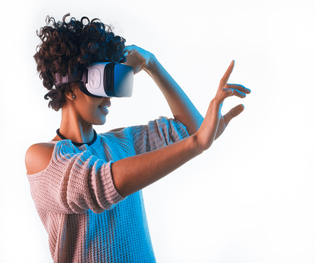Governments, physicians and health care businesses are becoming more interested in utilizing Virtual Reality for therapeutic treatments according to the Medical Virtual Reality (MedVR) group at the University of Southern California Institute for Creative Technologies. The institute is dedicated to exploring where VR can assist in traditional approaches in diverse fields that include psychology, medicine, neuroscience, and physical and occupational therapy.
Founded in 1999 and sponsored by the U.S. Army, ICT has already developed a treatment for PTSD created by Skip Rizzo, associate director for medical virtual reality at ICT. In fact, for the past ten years they have been working with military on ways to use Virtual Reality (VR) for therapies in mental health, motor and cognitive skills rehabilitation, and clinical assessment and training skills.
The Department of Defense initially funded the project in 2005 to treat soldiers’ Post-Traumatic Stress Disorder. Using Rizzo’s system, “Bravemind,” VR can accurately recreate war zone experience for the patient to initiate “extinction learning” which can shut down the over-stressed “flight or fight response” the primary cause of PTSD symptoms. In conjunction with traditional therapies the Army has found “Bravemind” to be successful in relieving symptoms of PTSD.
According to an article by ABI Research, therapy and training services have the highest opportunities for utilizing VR and they forecast that VR services will more than triple in just 5 years, from a current $8.9-million to $285-million in 2022. Many healthcare facilities are already implementing or are in trial for VR simulations to treat pain management, anxiety, PTSD, and neuro-recovery.
Cedars-Sinai Hospital in Los Angeles provides VR to their patients to help relieve stress and reduce pain. Using VR goggles, patients can “escape” from the hospital room to “visit” beautiful landscapes, or take part in class at an art studio or swim with the whales in a beautiful blue ocean.
Not just for recreation and gaming, VR is finding many uses in medical care including an improved virtual visit experience for family that may be too far away for a physical visit; others are using VR on kids to distract them during chemotherapy treatments; and VR is currently being used to help in stroke recovery. The number of hospitals and institutions interested in using VR for training and education is consistently growing, while most researchers agree that VR may even assist in reducing the costs of health care.
One area of medical health not yet well-suited for VR is in surgical applications. Most medical professionals believe that surgeries require too high a demand in accuracy and current VR quality has limitations. However, ABI Research and the medical community believe that VR is more efficient in training or therapeutic applications, and will continue to grow as an alternative or assistive choice in health care.









